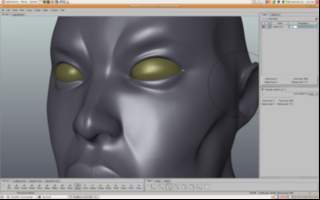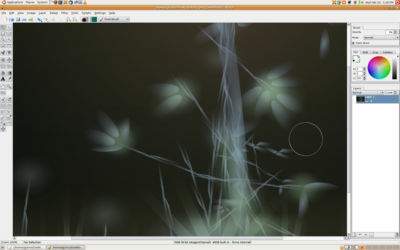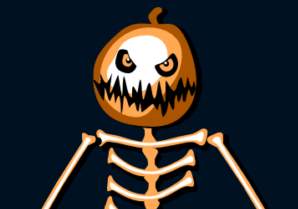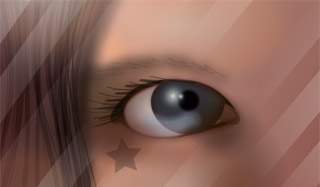Artist meets open source
By giZMo/farbrausch, February 19th 2008
About a year ago I switched to Linux for my non-artistic computer needs. I tried
this every now and then over the past decade but my attempts always ended up in
half a system and lots of frustration. This changed when I stumbled across a liveCD
from Ubuntu and to my surprise my laptop was fully supported incl. the 3d
hardware and even the graphics tablet worked more or less out of the box. So I
installed Ubuntu and a few weeks later I was quite comfortable with my Linux
system... Firefox incl. flashplugin is equal to its Windows pendant, Gnomecommander
is a weak but ok replacement to Total Commander, Thunderbird is
annoying but usable, eye-of-gnome is not as good and fast as ACDsee (v3.1 or
earlier) but imo still very good, xchat doesn't have auto-tiling but is otherwise an
excellent chat-client and vlc is possibly the best movieplayer ever. So there wasn't
very much i missed... well, except of course all my graphics tools :)
The old and the new together
So I went on a quest to get my daily
used tools up and running under Linux:
Mudbox, XSI, Zbrush and Photoshop.
Using virtualbox I was able to install an
old and unused copy of w2k on a virtual
machine that, to my disappointment,
didn't support 3d acceleration. Hm, ok,
too bad.. So I tried Photoshop and Flash
and both worked like a charm in my
guest system. Unfortunately my Wacom
didn't. At least not with the virtually
hosted Windows, so the whole thing felt
quite under par and turned at least Photoshop into a next-to-useless-experience
for me. But
 to be honest: booting an OS within another OS is somewhat cheating
anyway, so I tried Wine instead. I have got to admit that I didn't expect very much
and therefore I was positively surprised how excellent Wine performed. Zbrush3
and Mudbox worked as good as on native Windows, stable and without any
noticable speed-drops. The only downside was that Zbrush sported some
unfriendly error messages at startup but these can be safely ignored. I didn't try
using Photoshop with Wine so far but according to the Wine-infopage it works quite
well for many users out there. For XSI on the other hand exists a direct Linux port
(yay!) so no Wine needed. Unfortunately this little gem is Red Hat Linux only, and
right now I am not willing to jump through hoops and replace my system just to
give it a try.. With Mudbox and Zbrush fully functional I am more than happy at the
moment plus I have high hopes that Softimage will catch on and deliver a
Debian/Ubuntu version someday.
to be honest: booting an OS within another OS is somewhat cheating
anyway, so I tried Wine instead. I have got to admit that I didn't expect very much
and therefore I was positively surprised how excellent Wine performed. Zbrush3
and Mudbox worked as good as on native Windows, stable and without any
noticable speed-drops. The only downside was that Zbrush sported some
unfriendly error messages at startup but these can be safely ignored. I didn't try
using Photoshop with Wine so far but according to the Wine-infopage it works quite
well for many users out there. For XSI on the other hand exists a direct Linux port
(yay!) so no Wine needed. Unfortunately this little gem is Red Hat Linux only, and
right now I am not willing to jump through hoops and replace my system just to
give it a try.. With Mudbox and Zbrush fully functional I am more than happy at the
moment plus I have high hopes that Softimage will catch on and deliver a
Debian/Ubuntu version someday.
The open source alternatives
But the most interesting question is: What cool open source tools are out there?
Since I was still missing a good low-poly

modeller and a solid Photoshop
replacement, these have been my main targets. I've downloaded and tried
everything I could get my hands on and spotted a few rare gems. My first tool of
choice was Gimp, of course and without going into detail my advice is: If you are
an artist and want to happily paint under Linux: Stay away from the Gimp! This tool
is a gigantic big collection of more or less cool and state of the art functions that
are thrown together in a GUI that you simply don't want to use. period. Let them
Linux-geeks have their fun with it and use Krita instead. it is way ahead when it
comes to a clean and nice user interface. The keyboard shortcuts could be better
though (you still need two
hands on the keyboard for
quite a lot of actions, which is
bad since normally you want to
keep one hand on the
mouse/pen and the other one
resting over the keyboard to
strike shortcuts (preferably on
the left side)), the brushengine
doesn't mix colors as precisely
and accurately as Painter and
Photoshop do (rounding
issues?) and I miss a quicker
way to access different brushes
(like the brushmenue floating
or docked to the GUI
somewhere instead of a popup)... I assume these issues will be sorted out sooner
or later and all in all Krita is a lot more fun already than any other open source
pixel based painting application I've come across...
Next in the line was Blender. Despite my experience with the other famous and
kinda overhyped linux graphics tool I gave it a try and was pleasantly surprised.
While Blender felt very awkward as a lowpoly modeller UI-wise and the core clearly
shows its age with tools and workarounds that are very 1995-ish it had some state
of the art killer-features I didn't really expect. The LSCM UV-unwrapping tool is
awesome. Those of you who have used Roadkill for Max/Maya/XSI know what I
mean. Apart from Headus UV-layout Blender/Roadkill is the single best UVunwrapping
tool available. Another great feature is Sculpt mode. Yep, sculpting!
They implemented a full fletched Zbrush v2 style sculpting application into
Blender. I doodled around with it for a few days and the only downside is that the
tools are not designed for a real fast workflow UI-wise (this seems to be a general
problem with many open source tools, they are not designed to be used 8 hours a
day). Noteworthy is the Blender retopo-paint tool, although it had some weird
orientation issues with the created polygons (speaking of 1995-ish problems:) it
was exactly how I always imagined a retopo tool and never dared to ask: you
simply paint a wireframe onto a highres mesh. Simple as that. Great stuff, really.
On the modelling application-front there
were two apps standing out: Wings 3D and
K-3D. Unfortunately I didn't have
enough time to toy around in order to
properly comment on
 them here right now.
Both seem to be quite capable and
especially K-3D is on my list for further
investigation since I smell a lot of future
potential.
them here right now.
Both seem to be quite capable and
especially K-3D is on my list for further
investigation since I smell a lot of future
potential.
Last but not least I have to talk about
Inkscape. I never expected to use a vector
drawing application again after I abandoned
Illustrator somewhat ten years ago and
continued to fake all my 2D vector stuff with

whatever major 3D app I was using... Inkscape brought me back to 2D vector
illustration. It features a nice freehand brush that auto-corrects stroke jitter and
low sampling rates (unlike Photoshop). With that freehand/calligraphic brush you
have instant clean comic style. On top of that you can blur any object to gain
some really cool effects (see my second example... it doesnt look exactly like a
vector drawing anymore, does it?).
The GUI is nice and clean with just a
few minor flaws and the latest beta
features some kickass new tools
that I haven't seen anywhere before
in a 2D painting app (vector and
pixelbased), most notably the new
tweak brush with its pinch/push/etc
modes (equally to Mudbox or
Zbrush) is something I never want to
miss again. Of course, it's not all
bells and whistles: Inkscape has
some pretty annoying workflow
aspects, too... but overall it's a good match between left-brained technical vector
drawing and the stroke-driven chaotic-intuitive workflow most artists like myself
inherit.
Conclusion
I have no doubt that Linux and open source in general offer a solid future for us
artists... be it as a pure operating system running commercial applications (native
or through Wine), or with the constantly improving and partially groundbreaking
free alternatives such as Blender and Inkscape...
Text and illustrations by giZMo/farbrausch
 to be honest: booting an OS within another OS is somewhat cheating
anyway, so I tried Wine instead. I have got to admit that I didn't expect very much
and therefore I was positively surprised how excellent Wine performed. Zbrush3
and Mudbox worked as good as on native Windows, stable and without any
noticable speed-drops. The only downside was that Zbrush sported some
unfriendly error messages at startup but these can be safely ignored. I didn't try
using Photoshop with Wine so far but according to the Wine-infopage it works quite
well for many users out there. For XSI on the other hand exists a direct Linux port
(yay!) so no Wine needed. Unfortunately this little gem is Red Hat Linux only, and
right now I am not willing to jump through hoops and replace my system just to
give it a try.. With Mudbox and Zbrush fully functional I am more than happy at the
moment plus I have high hopes that Softimage will catch on and deliver a
Debian/Ubuntu version someday.
to be honest: booting an OS within another OS is somewhat cheating
anyway, so I tried Wine instead. I have got to admit that I didn't expect very much
and therefore I was positively surprised how excellent Wine performed. Zbrush3
and Mudbox worked as good as on native Windows, stable and without any
noticable speed-drops. The only downside was that Zbrush sported some
unfriendly error messages at startup but these can be safely ignored. I didn't try
using Photoshop with Wine so far but according to the Wine-infopage it works quite
well for many users out there. For XSI on the other hand exists a direct Linux port
(yay!) so no Wine needed. Unfortunately this little gem is Red Hat Linux only, and
right now I am not willing to jump through hoops and replace my system just to
give it a try.. With Mudbox and Zbrush fully functional I am more than happy at the
moment plus I have high hopes that Softimage will catch on and deliver a
Debian/Ubuntu version someday.

 them here right now.
Both seem to be quite capable and
especially K-3D is on my list for further
investigation since I smell a lot of future
potential.
them here right now.
Both seem to be quite capable and
especially K-3D is on my list for further
investigation since I smell a lot of future
potential.
